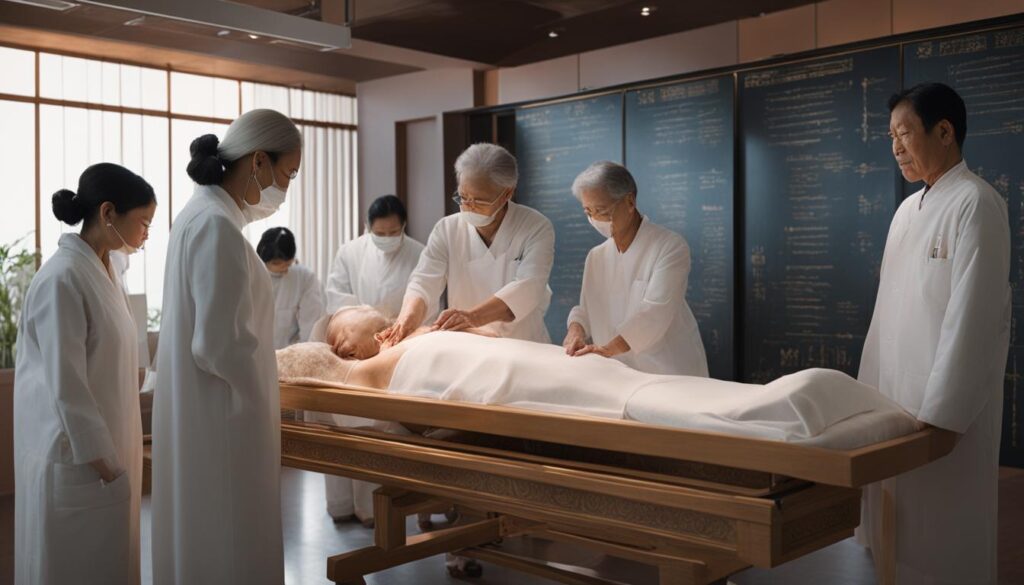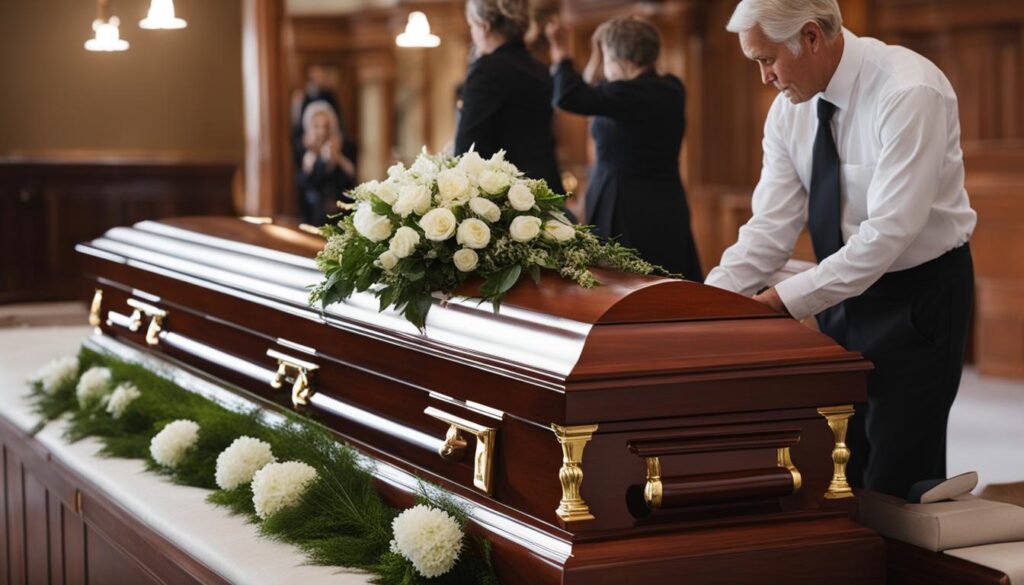We may earn money or products from the companies mentioned in this post.
Dealing with the death of a loved one is never easy. However, understanding the after-death body care process can help ensure that your loved one’s memory is preserved with dignity and respect. In this article, we will provide you with a comprehensive guide to after-death body care.
We will explore the various options and essential procedures involved in caring for a body after death. We will discuss the significance of after-death body care and why it is essential for preserving the memory of the deceased. Additionally, we will explain the processes and techniques involved in funeral home body preparation and the embalming process.
Mortuary rituals and practices are also crucial when it comes to after-death body care. Different cultures and religions have unique rituals for preparing the body, and we will explore these in-depth. Furthermore, we will discuss modern mortuary preservation techniques such as cryopreservation and natural body preservation, and their implications.
Finally, we will examine the legal and ethical considerations surrounding after-death body care, including the rights and responsibilities of funeral homes and families.
Key Takeaways:
- After-death body care is essential for preserving the dignity and memory of the deceased.
- Families have various options and procedures available when caring for a body after death.
- The embalming process is a common procedure performed during after-death body care.
- Mortuary rituals and practices vary among cultures and religions.
- Modern mortuary preservation techniques such as cryopreservation and natural body preservation have emerged in recent years.
- Legal and ethical considerations play a crucial role in after-death body care.
The Importance of After-Death Body Care
After-death body care, also known as post-mortem body care, is a vital aspect of the funeral process. It involves the preparation and preservation of the deceased body, ensuring that it is presentable for viewing and burial.
Proper after-death body care is essential for preserving the dignity and memory of the deceased. It allows family and friends to say their final goodbyes in a respectful and peaceful manner.
Moreover, after-death body care can have a significant impact on the grieving process. Seeing the deceased in a peaceful and well-prepared state can provide closure and comfort for loved ones.
However, neglecting after-death body care can have negative consequences. A poorly preserved body may deteriorate rapidly, causing distress and discomfort for those who wish to view it.
“The care of the dead is some of the most sacred work that we do, and it is vital to the healing process of the families we serve.”
Therefore, it is crucial to prioritize after-death body care and ensure that the proper procedures are followed.
Funeral Home Body Preparation
Funeral homes are responsible for preparing the body after death, ensuring it is clean, preserved, and ready for viewing or burial. Funeral home body preparation involves several essential procedures, including:
| Procedure | Description |
|---|---|
| Washing and Cleaning | The body is washed and cleaned to remove any dirt, debris, or bodily fluids. |
| Embalming | The process of embalming involves the use of chemicals to preserve the body and prevent the growth of bacteria, ensuring it is suitable for viewing or burial. |
| Dressing and Cosmetics | The body is dressed in the chosen outfit and cosmetics are applied to enhance its appearance. |
| Casketing | The body is placed in a casket for viewing or burial. |
Corpse preservation is a critical part of funeral home body preparation, helping to ensure that the body remains intact and presentable for the duration of the funeral service. Funeral homes use various methods to preserve the body, such as refrigeration, until the time of visitation or burial.
The Embalming Process
Embalming is a vital aspect of after-death body care that involves the injection of chemicals into the deceased’s body to slow down the natural process of decomposition.
Throughout history, the embalming process has been refined through new techniques and substances to ensure that a body is preserved for as long as possible. Modern embalming typically involves:
- Arterial injection: A mixture of formaldehyde, water, and other chemicals is injected into the deceased’s circulatory system through the carotid artery. This solution preserves the body’s tissues, organs, and features.
- Cavity injection: A hypodermic needle is used to inject the embalming solution into the organs and areas of the body where blood is inaccessible through the arterial injection. This process is often used in conjunction with the arterial injection.
- Surface embalming: This is the application of embalming fluid directly to the skin, which helps to preserve the skin’s elasticity and texture, giving the body a lifelike appearance.
The embalming process typically takes around 2-3 hours and can cost between $500-$1,200, depending on factors such as the level of preservation required, local regulations, and the funeral home’s pricing.
While embalming is a widely accepted practice, it is not always necessary. Families may opt for alternative methods, such as refrigeration or natural burial, which do not involve the use of embalming chemicals. It is essential to consider the deceased’s wishes and family traditions when deciding on the most appropriate after-death body care.
“Embalming is a complex process that requires proper training and certification. Only licensed professionals should perform this procedure to ensure the safety of the deceased and the embalmer.”
Mortuary Body Care
Aside from embalming, there are other mortuary body care procedures that funeral homes may offer to prepare a body for viewing and burial. These may include:
| Procedure | Description |
|---|---|
| Dressing and Cosmetics | The funeral home may offer dressing services, which involve dressing the deceased in their chosen clothing and styling their hair and makeup. |
| Casketing | The body is placed in a casket, which may be open or closed, depending on family preferences and local regulations. |
| Restorative Art | If the deceased suffered from injuries or other physical damage, restorative art techniques may be used to enhance their appearance and restore their features. |
Mortuary body care is an important component of funeral services, as it allows for loved ones to pay their respects and say goodbye to the deceased in a dignified and respectful manner.
Understanding the different aspects of after-death body care, including the embalming process and mortuary body care, can help individuals make informed decisions when planning funeral arrangements for their loved ones.
Mortuary Rituals and Practices
After-death body care encompasses various rituals and practices, many of which differ depending on culture and religion. These practices play a crucial role in honoring the deceased and providing closure for their loved ones.
Muslim Mortuary Rituals
Islamic tradition prescribes specific mortuary rituals that involve washing and shrouding the body. Family members and community members perform the washing, known as “ghusl,” and wrap the body in three white sheets. The body is then typically buried within 24 hours, without embalming or any other preservation techniques. The focus is on respecting the deceased and fulfilling their religious obligations.
Jewish Mortuary Rituals
Jewish tradition also has specific rituals for after-death body care. The body is prepared for burial by a “Chevra Kadisha,” a group of volunteers who wash, dress, and accompany the deceased to the grave. The body is not embalmed, and burial usually takes place within 24 hours of death. Jewish tradition also prohibits cremation.
Christian Mortuary Rituals
Christian mortuary rituals can vary depending on denomination and cultural traditions. Many Christians opt for embalming and a viewing, but some prefer a simple burial without any embalming or preservation. Catholic tradition involves a wake, funeral mass, and burial in a Catholic cemetery, with the body present for the mass.
Buddhist Mortuary Rituals
Buddhist tradition places great emphasis on the transition from life to death. After-death body care involves washing the body and placing it in a casket or urn, often accompanied by chanting from Buddhist monks. In some Buddhist communities, the body may be cremated, and the ashes placed in a stupa or temple.
Hindu Mortuary Rituals
Hindu mortuary rituals emphasize the cyclical nature of life and death. After death, the body is washed and prepared for cremation by family members. In some cases, the body may be embalmed or preserved for a short period to allow family members time to celebrate the life of the deceased. The ashes are typically scattered in a sacred body of water.
Final Body Preparations
Regardless of cultural or religious traditions, final body preparations are a crucial aspect of after-death body care. These preparations ensure that the body is presentable for any viewings or services and provide a sense of closure for loved ones. Some common final body preparations include dressing the body, applying makeup, and arranging the body in a peaceful pose.
Modern Mortuary Preservation Techniques
Traditional embalming has been the primary method of mortuary body care for over a century. However, in recent years, new techniques and technologies have emerged that offer different options for preserving a body after death. In this section, we will explore some of the modern mortuary preservation techniques available today.
Cryopreservation
Cryopreservation is a process that involves freezing a body shortly after death to preserve it. The body is placed in a container and covered with ice, which is then slowly replaced with a chemical solution to preserve the tissues and organs. Cryopreservation is often used in research or for individuals who wish to be cryogenically preserved in hopes of being revived in the future.
Natural Body Preservation
Natural body preservation is a process that involves using natural substances to delay the decomposition of a body. This technique is often favored by those who prefer a more environmentally friendly option. Some natural body preservation techniques include:
| Technique | Description |
|---|---|
| Refrigeration | By keeping a body cool, decomposition is slowed down. Refrigeration is a common technique used in funeral homes. |
| Organic Preservation | This technique involves using essential oils and other natural compounds to preserve the body and give it a pleasant scent. |
| Green Burial | Green burial is a practice that involves burying the body in a biodegradable coffin or shroud, without embalming. This allows the body to decompose naturally and return to the earth. |
While natural body preservation techniques are not as widely used as traditional embalming, they are becoming more popular as people seek alternative options for after-death body care.
Alternatives to Embalming
There are some alternatives to traditional embalming that are gaining popularity. These methods do not involve the use of chemicals and are often preferred by those who wish to have a more natural approach to after-death body care. Some alternatives include:
- Hydrolifting: This technique uses water to hydrate the tissues and make the body look more lifelike.
- Bio-cremation: Bio-cremation, or alkaline hydrolysis, is a process that uses water, heat, and pressure to break down the body’s tissues. The remains are then dissolved in water and returned to the family.
- Air Brushing: Airbrushing is a technique that uses makeup and other cosmetic products to make the body look more lifelike.
While these alternatives are not as common as traditional embalming, they offer unique options for after-death body care.
Legal and Ethical Considerations
After-death body care is a highly regulated industry governed by various legal and ethical considerations. Funeral homes and families must follow these guidelines to ensure proper care for the deceased and avoid legal penalties.
Legal Considerations
The Federal Trade Commission (FTC) regulates the funeral industry in the United States. The Funeral Rule, established by the FTC in 1984, outlines the rights and responsibilities of funeral homes and families. The Funeral Rule requires funeral homes to provide pricing information for funeral services and prohibits them from requiring customers to purchase certain services or items.
State laws also regulate the funeral industry to varying degrees. These laws may include requirements for funeral home licensure, embalming, and cremation. Families should research the state laws in their area to ensure compliance with regulations.
Ethical Considerations
Along with legal considerations, there are ethical considerations that funeral homes and families should adhere to. The National Funeral Directors Association (NFDA) provides codes of ethics for funeral professionals to follow. These codes emphasize the importance of treating the deceased with respect and dignity, providing compassionate care to grieving families, and maintaining the integrity of the funeral service.
One ethical consideration that may arise in after-death body care is the decision to donate the deceased’s organs or tissues. Individuals must make this decision before death, or family members may make the decision on their behalf. Funeral homes must handle donated bodies with the utmost care and respect, following the donation organization’s protocols.
Conclusion
After-death body care is a vital part of the funeral process that involves several procedures and considerations. Understanding the available options is crucial in making informed decisions about the care of the deceased loved one’s body.
From funeral home body preparation to embalming and mortuary rituals, different methods and techniques are available to preserve the body and honor the memory of the deceased. Modern preservation techniques such as cryopreservation and natural body preservation offer new alternatives to traditional embalming processes.
However, it is essential to consider legal and ethical considerations when choosing after-death body care options. Funeral homes and families have specific rights and responsibilities that must be adhered to, and laws and regulations governing after-death care vary by state.
Overall, after-death body care plays a crucial role in preserving the dignity and memory of the deceased. By understanding the options available, individuals can make informed decisions about the care of their loved one’s bodies after death.
Remembering the Importance of After-Death Body Care
Though it may be challenging to consider the idea of after-death body care, it is a crucial step in the funeral process. Post-mortem body care is an essential step in preserving the memory of our loved ones and giving them the dignity they deserve.
By understanding the significance of after-death body care, individuals can take necessary steps to ensure their loved ones are honored properly. With modern preservation techniques and careful consideration of legal and ethical considerations, families and funeral homes can work together to give the deceased a respectful send-off.
Thank you for reading this comprehensive guide to after-death body care. We hope that this information has been helpful to you in understanding the processes and considerations involved in caring for your loved one’s body after death.
FAQ
What is after-death body care?
After-death body care refers to the procedures and processes involved in caring for a deceased individual’s body after they have passed away.
Why is after-death body care important?
After-death body care is important for preserving the dignity and memory of the deceased. It ensures proper handling, preparation, and presentation of the body during funeral and burial services.
Who is responsible for after-death body care?
The responsibility for after-death body care usually falls on funeral homes or mortuaries. They have the knowledge, facilities, and expertise to perform the necessary procedures and preparations.
What does funeral home body preparation involve?
Funeral home body preparation includes various procedures such as embalming, dressing, cosmetology, and casketing. These processes aim to present the deceased in a dignified manner for viewing and burial.
What is the purpose of embalming?
Embalming is a process that temporarily preserves the body, slows down decomposition, and enhances its appearance for public viewing and extended visitation periods.
Are there alternatives to embalming?
Yes, there are alternative methods to embalming, such as refrigeration or natural body preservation techniques. These alternatives may be chosen based on personal, cultural, or religious preferences.
What are mortuary rituals and practices?
Mortuary rituals and practices are customs and traditions specific to different cultures and religions. They involve specific procedures for after-death body care that align with the beliefs and practices of the deceased and their community.
What are modern mortuary preservation techniques?
Modern mortuary preservation techniques include innovative methods like cryopreservation and natural body preservation. Cryopreservation involves freezing the body, while natural body preservation involves using non-toxic substances to slow down decomposition.
What legal and ethical considerations apply to after-death body care?
After-death body care is subject to laws and regulations that vary by jurisdiction. These considerations involve the proper handling of human remains, the rights of the deceased and their families, and the ethical responsibility of funeral homes and professionals.
What should I consider when making decisions about after-death body care?
When making decisions about after-death body care, it is essential to consider personal, cultural, religious, and financial factors. It is also helpful to consult with professionals to understand the available options and make informed choices.
Affiliate Disclosure: This post may contain affiliate links. If you purchase through our link, we may receive a small commission, but at no additional cost to you. For more information, please see our Disclosure statement.



